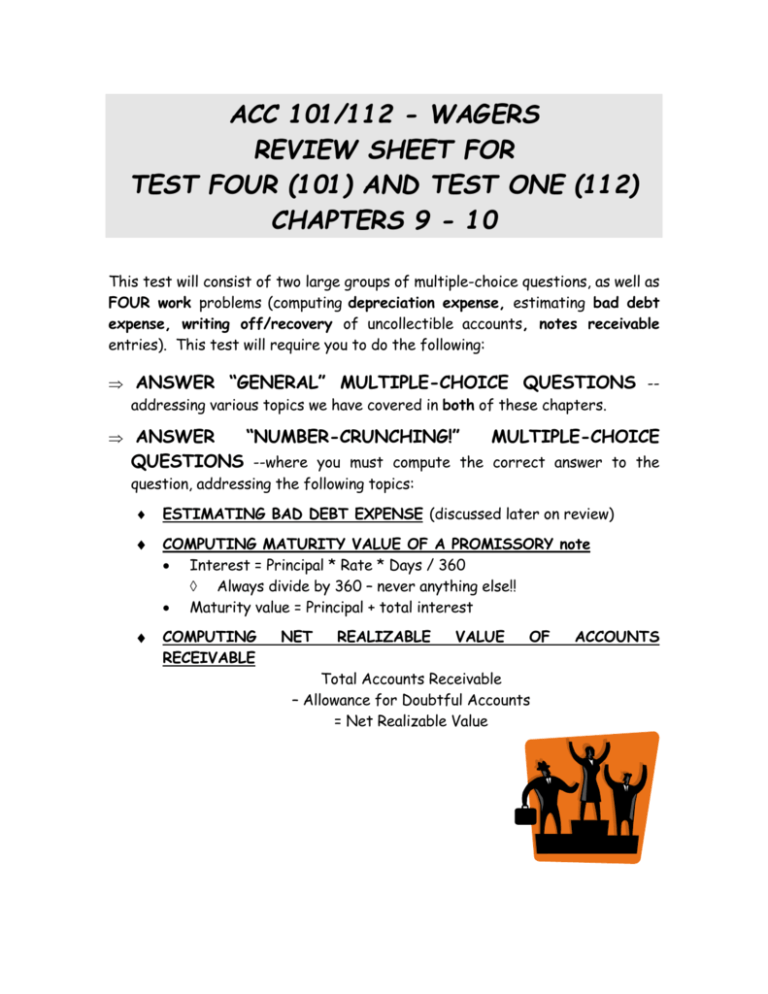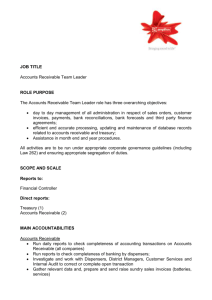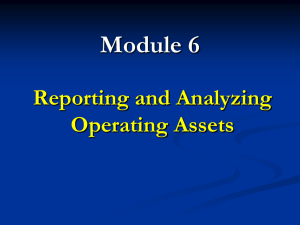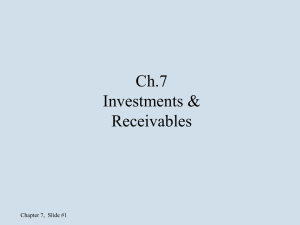OLD Wagers ACC 101 Test 4 Review 09
advertisement

ACC 101/112 - WAGERS REVIEW SHEET FOR TEST FOUR (101) AND TEST ONE (112) CHAPTERS 9 - 10 This test will consist of two large groups of multiple-choice questions, as well as FOUR work problems (computing depreciation expense, estimating bad debt expense, writing off/recovery of uncollectible accounts, notes receivable entries). This test will require you to do the following: ANSWER “GENERAL” MULTIPLE-CHOICE QUESTIONS -addressing various topics we have covered in both of these chapters. ANSWER “NUMBER-CRUNCHING!” MULTIPLE-CHOICE QUESTIONS --where you must compute the correct answer to the question, addressing the following topics: ESTIMATING BAD DEBT EXPENSE (discussed later on review) COMPUTING MATURITY VALUE OF A PROMISSORY note Interest = Principal * Rate * Days / 360 Always divide by 360 – never anything else!! Maturity value = Principal + total interest COMPUTING RECEIVABLE NET REALIZABLE VALUE OF Total Accounts Receivable – Allowance for Doubtful Accounts = Net Realizable Value ACCOUNTS ACC 101 - Review for Test 4 Chapters 9 - 10 - Wagers Page 2 of 8 DEPLETING A NATURAL RESOURCE Depletion Rate = Cost of Resource / Total Units of Resource Depletion Expense = Depletion Rate * Number of Units Extracted Journal entry Depletion Expense Accumulated Depletion PURCHASING AN ASSET - know the various costs that are (and ones that are not, like operating costs, vandalism, damage, etc.!) debited to the asset account What you pay for the asset plus all reasonable and necessary costs incurred to get the asset in place and in service COMPUTING DEPRECIATION EXPENSE AND BOOK VALUE, including computing depreciation expense for partial periods (discussed later on this review) DISPOSING OF AN ASSET Cash (proceeds, if any) Accumulated Depreciation (to zero out) Loss on Sale (debit losses, like expenses) Asset (ORIGINAL COST: to zero out) Gain on Sale (credit gains, like revenues) One or other, not both! Compare the PROCEEDS to the asset’s BOOK VALUE (Cost Accumulated Depreciation) to see if you have a gain or loss Are proceeds LESS THAN book value? Difference is a loss Are proceeds GREATER THAN book value? Difference is a gain REVISING DEPRECIATION EXPENSE Book Value – Revised Residual REMAINING life ACC 101 - Review for Test 4 Chapters 9 - 10 - Wagers Page 3 of 8 PROBLEM: COMPUTE DEPRECIATION EXPENSE FOR THREE YEARS USING STRAIGHT-LINE, PRODUCTION UNIT, AND DOUBLE DECLINING BALANCE METHODS Hint: remember to start all calculations with the FULL cost of the asset – what we pay for it plus all reasonable and necessary costs to get it in place and in service! Straight-Line Depr. per Period = (Cost - Residual) / Estimated Useful Life Production Unit Depr. per UNIT = (Cost - Residual) / Estimated Units of Life Depreciation per PERIOD = Actual Units * Depreciation per Unit Double Declining Balance Depreciation per Period = Book Value * (2 / Life) Remember: Book Value = Cost - Accumulated Depreciation For the FIRST year of an asset’s life, Book Value is same as COST (since Accumulated Depreciation is ZERO to start off the first year)! You will not be required to compute depreciation expense for the last year of the asset’s life (where you have to “plug” the expense as the difference between its book value and its residual) ACC 101 - Review for Test 4 Chapters 9 - 10 - Wagers Page 4 of 8 PROBLEM: RECORD ADJUSTING ENTRY REQUIRED TO ESTIMATE BAD DEBT EXPENSE IN THE ALLOWANCE METHOD ADJUSTING ENTRY (regardless of method used to figure the amount, the entry itself is the same!) Bad Debt Expense () Allowance for Doubtful Accounts () “BASED ON NET SALES” Method (to compute amount of entry) Expense = Net Sales * % Ignore the existing balance in the Allowance account “BASED ON ACCOUNTS RECEIVABLE” AGING Method (to compute amount of entry) Compute the DESIRED ENDING BALANCE (target) for the Allowance account by aging Multiply amount in each category times the percent estimated to be uncollectible Add up all these amounts to determine the desired ending balance in the Allowance account Draw a T-Account for the Allowance account (record the current balance AND the target) then WORK BACKWARDS to figure the EXPENSE needed! You MUST CONSIDER existing balance in the Allowance account Hint: Aging – draw a T-Account for the Allowance Account (all the “A’s!”) ACC 101 - Review for Test 4 Chapters 9 - 10 - Wagers Page 5 of 8 PROBLEM: RECORD JOURNAL ENTRIES TO WRITE-OFF AN UNCOLLECTIBLE ACCOUNT AND RECORD THE RECOVERY OF AN ACCOUNT PREVIOUSLY WRITTEN OFF WRITE-OFF of an uncollectible account - ALLOWANCE Method Allowance for Doubtful Accounts () Accounts Receivable, Customer Name () WRITE-OFF of an uncollectible account - DIRECT WRITE-OFF (CHARGE-OFF) Method Bad Debt Expense () Accounts Receivable, Customer Name () RECOVERY of previously written-off account - ALLOWANCE Method TWO ENTRIES Accounts Receivable, Customer Name () Allowance for Doubtful Accounts () Cash () Accounts Receivable, Customer Name () RECOVERY of previously written-off account – DIRECT WRITE-OFF Method - TWO ENTRIES Accounts Receivable, Customer Name () Bad Debt Expense () Cash () Accounts Receivable, Customer Name () NOTE: underlined accounts are just to emphasize to you the difference between the entries in the allowance method versus direct write-off method ACC 101 - Review for Test 4 Chapters 9 - 10 - Wagers Page 6 of 8 PROBLEM: RECORD JOURNAL ENTRIES FOR A NOTE RECEIVABLE (TWO notes – one that matures in the SAME period it is issued, and another that is issued one period and matures the NEXT period, so you will be required to make an adjusting entry for the interest!) Formula to compute INTEREST = Principal * Rate * Days / 360 Please DON’T forget to multiply by the # days / 360 – students forget this often and then they get the wrong answer!! And never divide by any number other than 360!! Journal entries: for note that DOESN’T CROSS OVER YEAR-END To record receiving the note Notes Receivable () Accounts Receivable (), Cash (), Sales (), etc. To record the receipt of payment at maturity Cash () (amount = maturity value: principal + total interest) Note Receivable () (amount = principal) Interest Income () (amount = earned this period) To record maturity of note if note maker does NOT pay at maturity Accounts Receivable () Note Receivable () Interest Income () credits are the same as if we were paid! ACC 101 - Review for Test 4 Chapters 9 - 10 - Wagers Page 7 of 8 Journal entries: for note that DOES CROSS OVER YEAR-END To record receiving the note Notes Receivable () Accounts Receivable (), Cash (), Sales (), etc. Adjusting journal entry to accrue interest Interest Receivable () Interest Income () To record the receipt of payment at maturity Cash () (amount = maturity value: principal + total interest) Note Receivable () (amount = principal) Interest Receivable () (amount = accrued last period) Interest Income () (amount = earned this period) To record maturity of note if note maker does NOT pay at maturity Accounts Receivable () Note Receivable () Interest Receivable () Interest Income () credits are the same as if we were paid! Remember, every time you debit/credit Notes Receivable it MUST BE for the PRINCIPAL amount ONLY (never any interest)!! You only credit Interest Receivable (at maturity) IF the note was issued one period and matured in the next period, so you had to make an adjusting entry. If the note matures in the same period it was issued, you DON’T credit Interest Receivable at maturity ACC 101 - Review for Test 4 Chapters 9 - 10 - Wagers Page 8 of 8 The key to doing well on this test is PRACTICE, PRACTICE, and PRACTICE!! Some EXTRA homework problems (in addition to those that were assigned for in-class work or homework AND in addition to those given in the “Extra Practice Problems” on the web site) from your textbook that will help you assess your current level of knowledge on the certain topics are: Chapter 9 – Accounts Receivable (write-off/recovery entries; estimating bad debt expense) Exercises 9-5, 9-9, 9-10, 9-13, 9-14, 9-17 Problem 9-3A, 9-1B, 9-2B, 9-3B Chapter 9 – Notes Receivable Exercises 9-19, 9-23 Problem 9-5A, 9-6A, 9-4B, 9-5B, 9-6B Chapter 10 - Depreciation Expense Exercise 10-12, 10-11, 10-16 Problems 10-5A, 10-2B, 10-3B, 10-5B Multiple-choice questions Cost of asset: problems 10-1A, 10-1B Revising depreciation expense: practice exercises 10-5A. 10-5B Disposal of fixed asset: problem 10-5A, 10-5B Depletion: practice exercises 10-8A, 10-8B, problem 10-6B Be sure that by test day you can work homework problems WITHOUT having to constantly flip back to the textbook, handouts, etc.! Answers to all homework problems are available on-line! GOOD LUCK!!






